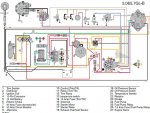Hello everyone,
I am having a weird problem while setting base timing on my 5.7 penta (the engine is a Frankenstein replacement engine, so, I cannot even tell the actual model number). The distributor is a Delco-style aftermarket replacement. As I understand it, I should see timing advancing 9 deg once the "shunt" is removed. It does not. I see no changes when connecting/disconnecting the shunt. I can tell that the shunt works since it does stop advancement at higher RPMs, i.e. timing stays the same throughout the full rpm range when shunt is connected. I also see timing advancing 7 deg (from initial 12) at 3000rpm when shunt is removed. So, it sort of works, except I see no advancement from initial 12 deg to target 21 at 600 rpm. So my total advancement is only 19. I went through 3 different modules, all do the same thing. Any ideas?
I am having a weird problem while setting base timing on my 5.7 penta (the engine is a Frankenstein replacement engine, so, I cannot even tell the actual model number). The distributor is a Delco-style aftermarket replacement. As I understand it, I should see timing advancing 9 deg once the "shunt" is removed. It does not. I see no changes when connecting/disconnecting the shunt. I can tell that the shunt works since it does stop advancement at higher RPMs, i.e. timing stays the same throughout the full rpm range when shunt is connected. I also see timing advancing 7 deg (from initial 12) at 3000rpm when shunt is removed. So, it sort of works, except I see no advancement from initial 12 deg to target 21 at 600 rpm. So my total advancement is only 19. I went through 3 different modules, all do the same thing. Any ideas?




















